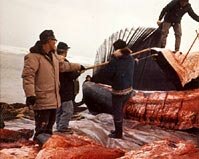|
Modern Alaska
Subsistence
 Cutting up a whale
Cutting up a whale
Akutan, AK, 1976
One of the important parts of the Alaska lands act, ANILCA, was a federal guarantee of a rural preference for the subsistence harvest of traditional resources fish and game. Native Alaskans in particular, but also non-Natives living in rural areas have used the resources of Alaska's land and waters for survival. More importantly, subsistence is both a cultural way of life and an economic necessity in many Alaska villages where there is very little cash income and few jobs. . People must hunt and fish in order to survive. Congress recognized that the creation of new conservation units in the state would present a hardship to such people if they were denied their traditional food sources. Title VIII of ANILCA contains the rural preference provision.
Subsistence Links:
http://www.r7.fws.gov/asm/anilca/title08.html
http://www.subsistence.adfg.state.ak.us/download/subupd98.pdf
http://www.r7.fws.gov/asm/home.html
http://www.alaskool.org/projects/ancsa/subsistence_chron/subchron.htm
http://www.cr.nps.gov/history/online_books/norris1/chap9a.htm
http://www.alaskool.org/projects/subsistence/timeline/default.htm |
Subsistence became a highly charged, highly visible and emotional issue in Alaska. It dominated much political debate in the 1990s. The management of fish and game on federal lands in several states is left to the states, unless the federal government finds it necessary to manage specific resources on its lands, such as in national parks, forests and fish and wildlife refuges.. ANILCA required the state of Alaska to recognize and enforce the Title VIII provision.
However, the rural preference in ANILCA is in conflict with the state constitution, which declares that Alaska's natural resources belong equally to all citizens. In 1978 the Alaska legislature had passed a law providing a subsistence preference for "customary and traditional uses . . . for direct personal or family consumption, and for customary trade, barter or sharing." In 1985, the state Supreme Court struck down that law. The legislature responded with a law, establishing a rural preference for persons residing in the area where the subsistence activity took place. This, too, the state Supreme Court would not allow.. Called by Gov. Cowper to a special session in 1990, the state House failed to pass a state constitutional amendment by one vote. Governor Hickel called a 1992 special session and proposed a whole new state system that would not comply with ANILCA, or return the state's management. This also failed to pass the legislature.
The situation was complicated by a separate question, involving navigable waterways. The title to these waters was guaranteed to the State of Alaska in ANILCA. The state would not guarantee the traditional fishing rights of Natives on Alaska's rivers, rivers from which Natives had traditionally used. . The federal government had protected the Native fishing right, but stopped doing so after the special legislative session in 1992. This prompted Natives to file suit in U.S. District Court (Katie John, et al. v United States), claiming that ANILCA's term "public lands" included navigable waters. The Hickel administration countersued (State of Alaska v Babbitt), claiming that ANILCA gives the federal Secretaries no power of direct management on any lands or waters of Alaska. This suit was later withdrawn by Gov. Knowles when it became clear that it would fail in the courts. On March 30, 1994, the U.S. District Court ruled in favor of the Natives,, holding that all navigable waters were under Title VIII's protections. I n other words, this meant that under ANILCA the federal government has jurisdiction over navigable waterways traditionally used by Natives for subsistence harvest. An appeal to the Ninth Circuit Court limited federal jurisdiction to "reserved" navigable waters only. Governor Knowles called two special sessions during his tenure to attempt to bring the state into compliance with ANILCA, but both were unsuccessful. Public opinion polls in the state have shown that most Alaskans support a constitutional amendment that would resolve the difficulty, and allow a rural subsistence preference. But some members of the state legislature believe that the state should not be forced into compliance with federal law. They have blocked passage of an amendment that would then be voted on in the next general election.
With the state out of compliance with ANILCA, the federal government took over management of subsistence hunting on federal lands. Federal resource management boards and regional councils review subsistence use patterns regularly. They solicit information and opinions from traditional users before creating any regulations that govern the implementation of the rural preference clause.
|

